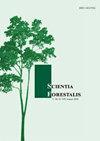Biomass modeling in a mixed plantation of Pinus taeda L. and Pinus elliottii Engelm
IF 0.4
4区 农林科学
Q4 FORESTRY
引用次数: 0
Abstract
The objective of this study was to compare three approaches to fit models to estimate forest biomass in a mixed plantation of Pinus taeda and Pinus elliottii with 16 years of age. The data came from the biomass of 60 trees sampled, 30 trees of Pinus taeda and 30 trees of Pinus elliottii. The aerial biomass was estimated through the regression analysis (independent adjustment and simultaneous adjustment) and the artificial intelligence method with the nearest neighbor techniques. The models were selected and compared based on the quality of the statistical indicators: adjusted determination coefficient (Raj), standard error of the relative estimate (Syx%), Akaike Information Criterion (AIC), Bayesian Information Criterion (BIC), Graphical analysis of residuals (%) and the ranking of the models. In the three approaches there were differences in total and component biomass estimates, being this difference associated with the heterogeneity of species (genetic variability by seminal origin), their components, and the lowest correlation of weight with diameter and height (allometric relationships). The technique of the nearest neighbor did not present satisfactory results, its use being recommended for a larger data base. Simultaneous adjustment was similar to the independent fitting method. However, the simultaneous equation has the advantage that when adding the biomass of the components, the result is compatible with the total biomass, which is more satisfactory for the estimation of total biomass.红松与湿地松混交林生物量模型研究
本研究的目的是比较三种拟合模型估算16年树龄红松和湿地松混交林森林生物量的方法。数据来自于60棵样本树的生物量,其中30棵是红松,30棵是湿地松。通过回归分析(独立平差和同步平差)和最近邻人工智能方法估算空中生物量。根据调整决定系数(Raj)、相对估计标准误差(Syx%)、赤池信息准则(AIC)、贝叶斯信息准则(BIC)、残差图形分析(%)和模型排名等统计指标的质量对模型进行选择和比较。在这三种方法中,总生物量和组分生物量估计值存在差异,这种差异与物种的异质性(种子来源的遗传变异性)及其组分有关,而重量与直径和高度的相关性最低(异速生长关系)。最近邻技术并没有呈现出令人满意的结果,它被推荐用于更大的数据库。同时平差类似于独立拟合方法。但联立方程的优点是,在加入各组分生物量时,结果与总生物量相容,更能满足总生物量的估算。
本文章由计算机程序翻译,如有差异,请以英文原文为准。
求助全文
约1分钟内获得全文
求助全文
来源期刊

Scientia Forestalis
Agricultural and Biological Sciences-Forestry
CiteScore
1.00
自引率
0.00%
发文量
39
期刊介绍:
Scientia Forestalis is a scientific publication of the IPEF – Institute of Forest Research and Studies, founded in 1968, as a nonprofit institution, in agreement with the LCF – Department of Forest Sciences of the ESALQ – Luiz de Queiroz College of Agriculture of the USP – São Paulo University. Scientia Forestalis, affiliated to the ABEC – Brazilian Association of Scientific Publishers, publishes four issues per year of original papers related to the several fields of the Forest Sciences.
The Editorial Board is composed by the Editor, the Scientific Editors (evaluating the manuscript), and the Associated Editors (helping on the decision of acceptation or not of the manuscript, analyzed by the Peer-Reviewers.
 求助内容:
求助内容: 应助结果提醒方式:
应助结果提醒方式:


